Michael Moorcock (b. 1939) is the Grand Master for sword & sorcery fiction today. To put it in perspective, it would be like having Robert E. Howard around in 1996. What started it all is Elric of Melnibone.
Moorcock went into the genesis of the character in the essay “The Secret Life of Elric of Melnibone.” He first was thinking of new Conan stories for the magazine Fantastic Universe but that magazine ended. He had run into editor Ted Carnell of Science-Fantasy who mentioned wanting some Robert E. Howard type fiction in the magazine. Moorcock sent in 10,000 words of Conan. Carnell made it known he did not want Conan but something on the lines of Conan.
Moorcock came up with Elric. There was a series of ten stories in Science-Fantasy 1961 to 1964. Elric was not a barbarian but then end product of thousands of years of civilization. Moorcock inverted Robert E. Howard’s creation. Elric is an albino weakling needing drugs for strength. He obtains the sword Stormbringer which sucks the soul and energy out of its victims and passing that energy onto Elric. The series starts with Elric destroying his home nation in a quest to regain his throne from his usurper cousin, Yrkoon. The following stories have Elric as a wandering adventurer. The series came to an end in 1964 where Moorcock destroyed the universe.
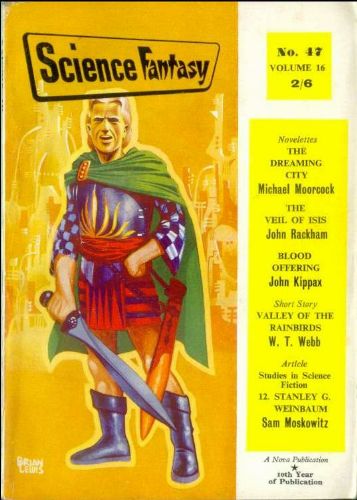
Moorcock would return to write a new Elric story for the L. Sprague de Camp edited The Fantastic Swordsmen in 1967. Neville-Spearman published two books shortly after the original magazine publication, The Stealer of Souls and Other Stories (1963) and Stormbringer (1965). Lancer Books would reprint both as paperbacks in 1967 as the Conan inspired sword & sorcery boom got off the ground.
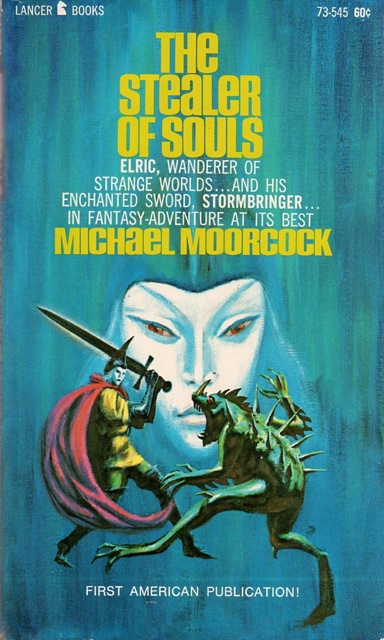
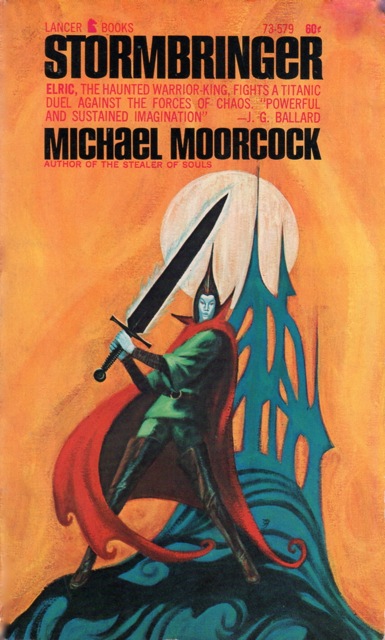
| Title | First Publication | Date |
| The Dreaming City | Science-Fantasy #47 | 1961 |
| While the Gods Laugh | Science-Fantasy #49 | 1961 |
| The Stealers of Souls | Science-Fanasy #51 | 1962 |
| Kings in Darkness | Science-Fantasy #54 | 1962 |
| The Flame Bringers | Science-Fantasy #55 | 1962 |
| To Rescue Tanelorn | Science-Fantasy #56 | 1962 |
| Dead God’s Homecoming | Science-Fantasy #59 | 1963 |
| Black Sword’s Brothers | Science-Fantasy #61 | 1963 |
| Sad Giant’s Shield | Science-Fantasy #63 | 1964 |
| Doomed Lord’s Passing | Science-Fantasy #64 | 1964 |
| The Singing Citadel | The Fantastic Swordsmen | 1967 |
| The Sleeping Sorceress | Fantastic | Feb-72 |
| Jade Man’s Eyes | Flashing Swords #2 | 1973 |
| The Lands Beyond the World | Flashing Swords #4 | 1977 |
Berkley Medallion published The Singing Citadel collection in 1970 which contained the title story, “The Master of Chaos,” a story set in Elric’s world, “To Rescue Tanelorn,” also in Elric’s world, and “The Greater Conqueror” which is unrelated.
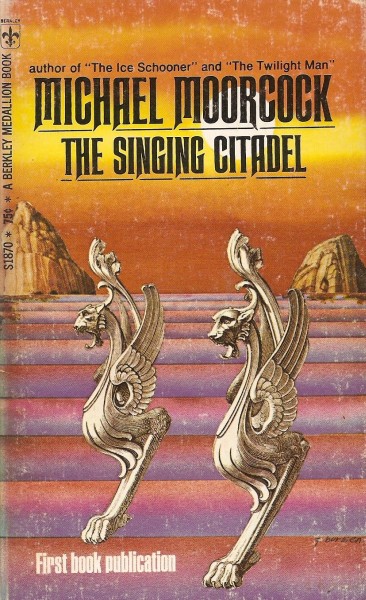
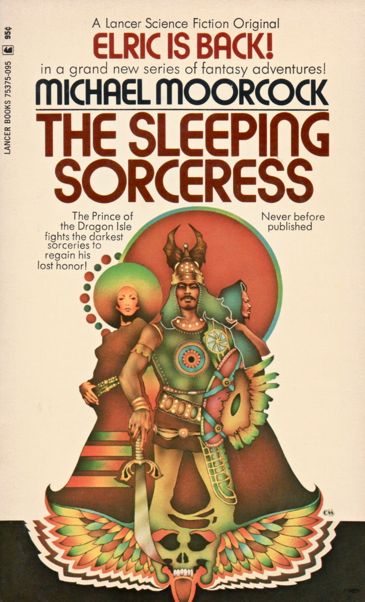
Moorcock returned to Elric in the 1970s 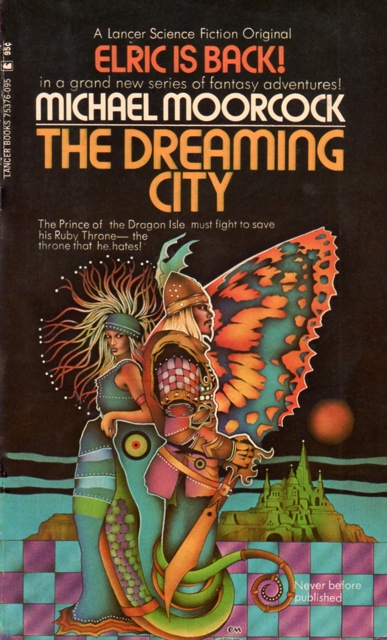 with two novels: The Sleeping Sorceress in 1971 and The Dreaming City in 1972, both by Lancer Books in the U.S. The Dreaminng City is the Elric origin story on how he got the sword Stormbringer.
with two novels: The Sleeping Sorceress in 1971 and The Dreaming City in 1972, both by Lancer Books in the U.S. The Dreaminng City is the Elric origin story on how he got the sword Stormbringer.
Moorcock would write two more Elric stories for Lin Carter’s Flashing Swords in the 1970s. Things became unified in 1976 when D.A.W Books put out the classic six volume set in chronological order. These editions also had to me the classic covers by Michael Whelan. Whelan did draw Elric more muscular than described in the stories but the colors and scenes were to Elric what Frazetta had been to Conan a decade before. Reading these slender paperbacks with cool covers were to me what reading the pulps must have been in the 1930s.
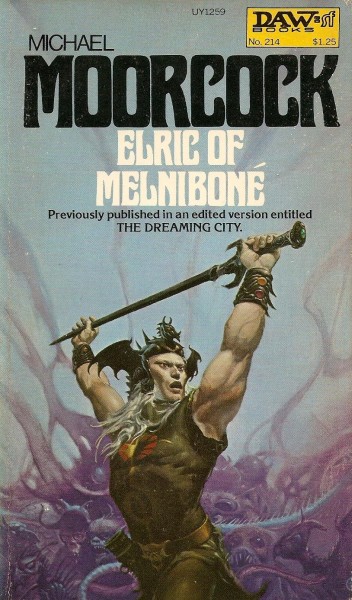
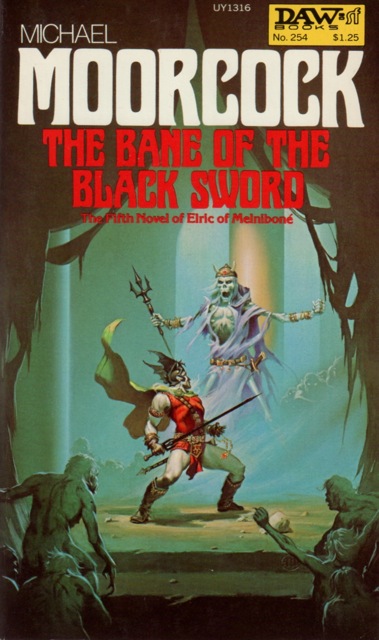
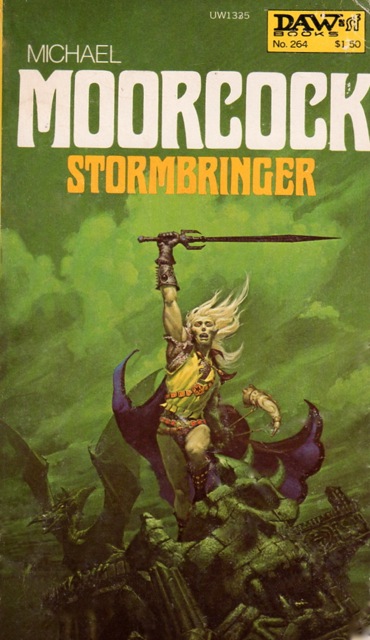
Berkley would reprint the books in 1983 with Robert Gould’s drab and whimpy covers.
Elric was something different and has been influential. If Robert E. Howard had based Conan on various Texan oil workers etc, Elric is something out of Swinging London, Carnaby Street dandy. If Conan is an Alpha Male in the Socio-Sexual Hierarchy, Elric is a Gamma.
The later Elric novels did not appeal to me much as Moorcock engaged in multi-verse shenanigans taking Elric out of his world to alternate dimensions.
That being said, I have enjoyed the last few Elric (and Rackhir the Red Archer) stories more that have appeared in the past eighteen or so years.
Shagadelic! 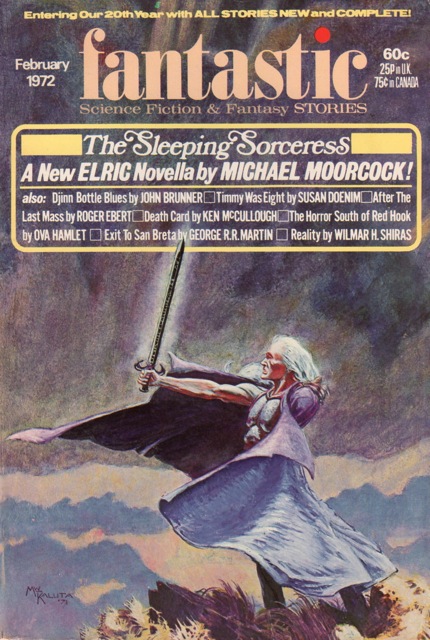
A seminal and hugely influential series, to be sure. Moreover one which, if encountered at the right age, will exert a fond regard for it ever afterwards. And if it had concluded with the writing of “Elric at the End of Time” in 1977, as it was intended to, then I daresay I’d harbour a more charitable opinion towards it.
However, those interminable revisions, retitlings, rearrangements and periodic crowbarring in of vastly inferior additions (plus authorised pastiches) utterly compromised its credibility, to my eyes. Added to which was the churlish, sneering attitude MM himself often directed at those who enthused most about it: “The prevailing message of my fantasy novels is that you shouldn’t be reading this stuff but something better instead”.
To be honest, I don’t think the original stories are particularly good or well written either. In contrast to the Conan canon, to which they constitute the complete antithesis, they boast few memorable scenes. The artistic success stems from the cumulative effect of the sumptuous imagery, delicious nomenclature and highly inventive conceits. [Worth mentioning here the other Elric book of the 1970s: THE SAILOR ON THE SEAS OF FATE. It encapsulates all that is best about the series. I defy anyone to read it and not want to take ship on that dark vessel with its blind steersman].
Its sad to reflect that a character which was born out of youthful enthusiasm is now both a debased franchise and an old man’s meal ticket. But then again, I always preferred the Hawkmoon books myself. And most people I know seem to favour Corum besides.